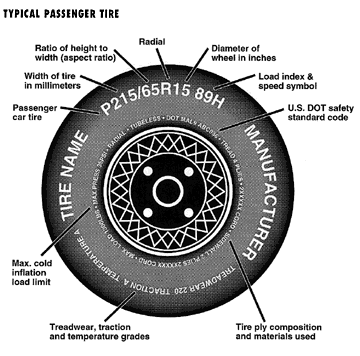A "B" in place of the "R" means the tire is belted bias construction. A "D" in place of the "R" means diagonal bias construction.
The maximum load is shown in lbs. (pounds) and in kg (kilograms), and maximum pressure in psi (pounds per square inch) and in kPa (kilopascals). Kilograms and kilopascals are metric units of measurement.
The letters "DOT" certify compliance with all applicable safety standards established by the Department of Transportation (DOT).
Adjacent to this is a tire identification or serial number. This serial number is a code with up to 11 digits that are a combination of numbers and letters.
The sidewall also shows the type of cord and number of plies in the sidewall and under the tread. The DOT requires tire manufacturers to grade passenger car tires based on three performance factors: treadwear, traction and temperature resistance.


